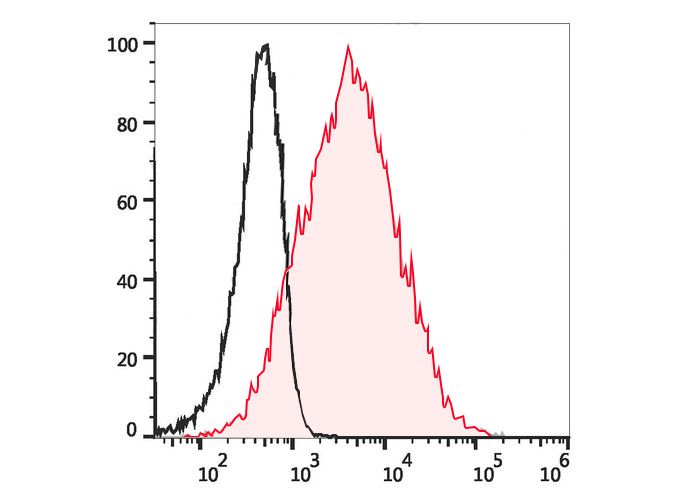Products
APC Anti-Mouse CD107a Antibody(1D4B)
- SPECIFICATIONS
- FIGURES
- CONDITIONS
- FAQS
- Product Name
- APC Anti-Mouse CD107a Antibody(1D4B)
- Catalogue No.
- APC-30199
- Form
- liquid
- Conjugation
- APC
- Conjugation Information
- APC is designed to be excited by the Red (627-640 nm) laser and detected using an optical filter centered near 660 nm (e.g., a 660/20 nm bandpass filter).
- Clonality
- Monoclonal
- Isotype
- IgG2a, κ
- Clone ID
- 1D4B
- Storage
- PBS with 0. 1% sodium azide, 1%BSA, pH 7.3, 2-8℃ for 12 months (Avoid repeated freeze / thaw cycles.)
- Alternative Names
- CD107 antigen-like family member Alysosomal membrane glycoprotein 1lysosome-associated membrane protein 1|LAMP-1|Lysosome-associated membrane glycoprotein 1|LAMP-1 antibody
- UniProt ID
- P11438
- Tested Applications
- FC
- Recommended dilution
- Volume per test: 5μL. Each lot of this antibody is quality control tested by flow cytometric analysis. The amount of the reagent is suggested to be used 5 µL of antibody per test (million cells in 100 µL staining volume or per 100 µL of whole blood). Please check your vial before the experiment. Since applications vary, the appropriate dilutions must be determined for individual use.
 C57BL/6 murine abdominal macrophages elicited by starch broth are stained with APC Anti-Mouse CD107a Antibody (filled gray histogram) or APC Rat IgG2a, κ Isotype Control (black histogram).
C57BL/6 murine abdominal macrophages elicited by starch broth are stained with APC Anti-Mouse CD107a Antibody (filled gray histogram) or APC Rat IgG2a, κ Isotype Control (black histogram).
- Background
- The 1D4B antibody recognizes CD107a which is also known as, Lysosome-Associated Membrane Protein 1 (LAMP-1). CD107a is one of the two major glycoproteins in lysosome membranes that provide useful markers to distinguish lysosomes from other organelles. CD107a may play a role in the lysosomal degradation of certain molecules. Mouse CD107a is a type I transmembrane glycoprotein. It consists of a 40-kDa core protein which is heavily glycosylated to form heterogeneous mature glycoprotein of 110-140 kDa. It is principally expressed in epithelial cells and macrophages in a variety of organs. Following activation, CD107a is relocated to the surface of some lymphocytes, macrophages, epithelial cells, endothelial cells, platelets, and tumor cells. Cell-surface CD107a may participate in intercellular adhesion and adhesion to the extracellular matrix. Cell surface CD107a expression can serve as a useful marker for cytotoxic NK and CD8+ T cells, as well as, some malignant tumor cells.
How many times can antibodies be recycled?
First, usually it's not suggested to recycle antibodies. After use, buffer system of antibodies has changed. The storage condition of recycled antibodies for different customers also varies. Thus, the performance efficiency of recycled antibodies can’t be guaranteed. Besides, FineTest ever conducted the antibody recycling assay. Assay results show recycling times of different antibodies also varies. Usually, higher antibody titer allows more repeated use. Customers can determine based on experimental requirements.
Notes: After incubation, we recycle rest antibodies to centrifuge tube and store at 4℃. High titer antibodies can be stored for a minimum of one week. Reuse about three times.
What are components of FineTest antibody buffer?
Components of FineTest antibody buffer are usually PBS with proclin300 or sodium azide, BSA, 50% glycerol. Common preservative is proclin300 or sodium azide, which is widely applied in the lab and industry.
How about the storage temperature and duration of FineTest antibodies?
Most antibodies are stored at -20℃. Directly-labeled flow cytometry antibodies should be stored at 2 - 8℃. The shelf life is one year. If after sales issues for purchased antibodies appear, return or replacement is available. Usually, antibodies can be still used after the one-year warranty. We can offer technical support services.
Is dilution required for FineTest antibodies? What’s the dilute solution?
Directly-labeled flow cytometry antibodies are ready-to-use without dilution. Other antibodies are usually concentrated. Follow the dilution ratio suggested in the manual. Dilute solution for different experiments also varies. Common antibody dilution buffers are acceptable(e.g. PBST, TBST, antibody blocking buffer).
How to retrieve antibodies for immunohistochemistry?
Common retrieval buffers: Tris-EDTA Buffer(pH 9.0); Citrate Buffer(pH 6.0)
Heat induced antibody retrieval:
Method 1: Water-bath heating: Put the beaker with retrieval buffer and slide in the boiling water bath. Keep the boiling state for 15min. Naturally cool to room temperature;
Method 2: Microwave retrieval: Put the beaker with retrieval buffer and slide in the microwave oven. Heat at high power for 5min, Switch OFF for 3min, Heat at medium power for 5min. Naturally cool to room temperature.
How to choose secondary antibodies?
(1) Secondary antibodies react with primary antibodies. Thus, secondary antibodies should be against host species of primary antibodies. E.g. If the primary antibody is derived from rabbit, the relevant secondary antibody should be against rabbit. E.g. goat anti rabbit or donkey anti rabbit.
(2) Choose secondary antibody conjugates according to the experimental type, e.g. ELISA, WB, IHC etc. Common enzyme conjugated secondary antibodies are labelled by HRP, AP etc. Fluorescin or dye labelled secondary antibodies are applied in immunofluorescence and flow cytometry(e.g. FITC, Cy3).
